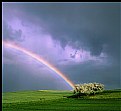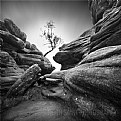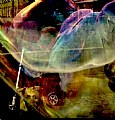| Photography Forum: Medium Format Photography Forum: |
 |
Q. Techniques for shooting with the intention of enlarging.

Asked by Emma James
(K=162) on 4/17/2003
|
When taking a photo what techniques and principles should I employ to ensure the best quality when I blow a photo up from a standard 13"x6"?
|
|
|
|
|
|
|

Charles Morris
(K=5969) - Comment Date 4/17/2003
|
13x6? some panorama format? for critically sharp images regardless of film, use a solid support. s studio stand, a sturdy tripod, a clamp, a beanbag if all else fails. once the camer is in place and it is not going anywhere, critical focus on something specific or/and observe hyperfocal limits and consider depth of field as part of the composition and select an aperture accordingly.
film choice can effect sharpness or the perception of sharpness if you blow it up big enough that grains starts to show. if you use black and white film, you can use filtration that limits the spectrum of light enterign the lens and this can have an effect on flare and chromatic aberration that would show up as softness of high contrast edges or an overall lack of contrast.
get a focus magnifier. these can be handy if the images ahve a pttern or teture that you can focus on with just a little extra help. another consideration is the film format. big negatives don't have to be magnified as much to make a big print.
in the act of printing, consider the enlarger. is it's lens up to the task? is the lightpath and optical train aligned correctly and perpendicular to the baseboard? does the print easel you use lay flat on the board?
when you fire the shutter, are you using a cable release or a wireless remote? do you use the mirror lockup, pre-release, or a self-timer to help eliminate shake when the shutter is triggered or fired?
just a few little thngs that might help.
2cents@large
|
|
|
|

David Goldfarb
(K=7611) - Comment Date 4/18/2003
|
Depends on your goals and standards, and how big you want to go.
The main thing that you can do to improve sharpness is to use a sturdy tripod, even when you don't think you need it. It's remarkable to see how much people spend on lenses and equipment while neglecting this fundamental, if humble, tool.
|
|
|
|

Zarazka Zarazkovich
(K=1510) - Comment Date 7/5/2003
|
Sharpness is one important thing that was mentioned here already. I would also say, that the correct composition is very important. If you crop too much, then obviously you cannot enlarge to the same extent without some quality loss.
One thing that many consider important, while it's not, is a film grain size. You have to remember, that larger print will be viewed from bigger distance, so if you can see the large ugly grain looking at the picture 12" from the eyes, it does not mean that it will look the same way from 5 feet.
|
|
|
|

Thalmees Salsa
(K=125) - Comment Date 7/18/2003
|
If I'm recommending something that related only to the photographer, equipment & the subject; I can summarise it in the following 12 points. Light of the subject is of greatest importance although I did not mention it here; because it differ with each subject and photographer while the following 12 points will not. These points should be the roll of thumb for any type of photography except when action is controlling the subject(e.g: sport photography).
In short they are:
1- Avoid vibrations.Tripod(realy sturdy one)is the best solution for very fast & very low shutter speeds.
2- Avoid vibrations. Mirror lockup(or any similar prerelease or self timer)with tripod are the best solution for shutter speeds between 1/60 to 2 sec.
3- Foucus properly.
4- Use any form of remote release.
5- A well made lens. German made lenses are the goldstandard by which other made may be compared.
6- A well made camera body that provide an optimum film flatness.
7- Use optimum f/number for that lens. Usually 2 f/stops from the widest.
8- Use optimum f/number for that scene(whatever it is). Consider depth of field & the permissible circle of confusion for your final print size.
9- Use a low speed fine grain Professional film.
10- Professional lab to process that film. The choice of chemistery type, ideal development along with the best paper for the subject are of great importance.
11- Work it thoughtfully(i.e: slowly).
12- Work at the optimum time for the scene(whenever it is).
I hope this is of help for any one.
Thanks.
|
|
|
|
|
















